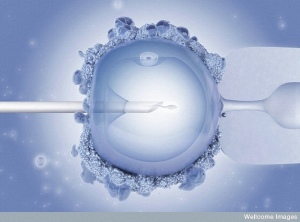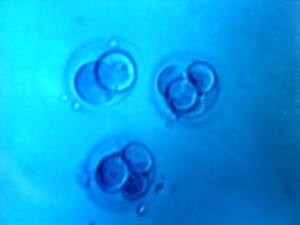Congratulations! You passed your final exam in IVF 101 and now are ready to get into the details of the IVF process in IVF 102.
In IVF 101 we described all the players in the IVF game. The first and one of the most important members of your baby dream team is your Reproductive Endocrinologist (RE). His title alone should give you a bit of insight into what all this In Vitro business is all about. Note that your RE is not called “Chief Baby Maker In Charge.” He does not hold a specialized degree in “Getting People Knocked Up”.
Sure, the emphasis of his training is to figure out how to get you pregnant, but the job title alone is an indication that what he really does is try to get your endocrine system and all its hormones working together to set the stage for pregnancy. Your RE is essentially an endocrine system manipulator and he has a variety of ways to adjust your hormones and help you make a baby.
It is impossible to describe all the different ways he can do this in one simple post. Because each of us is unique, the plan your doctor will give you is tailored to your needs. I can’t possibly speak to your individual situation. However I can give you an overview of the basics of the stages involved in IVF.
Step One- The Human Pin Cushion
Think all your needle woes begin when you start taking your IVF medication? Think again. When you sign up for IVF you and your partner will go through a ridiculous amount of diagnostic testing. Even if you completed many tests with your OB/GYN before moving on up to the big time, you will likely do it again. For the mommy wannabe, the clinic will test various hormone levels to make sure they are in the proper range. Tests will also be done on the thyroid to ensure its functioning properly. The RE could decide to run a number of other labs to rule out the possibility of autoimmune issues, although this was not done for me until we had a couple of failed cycles on the books.
Some tests like the sonohysterogram or hysteroscopy don’t involve needles but still totally violate you and remove any remaining modesty you had prior to turning to IVF. These tests involve checking your uterine cavity and fallopian tubes to look for potential clues as to why embryos aren’t implanting for you.
Your spouse, partner or sperm donor will also provide a sperm sample to inspect that his part of the equation is doing its part.
All involved parties will be tested for communicable diseases prior to beginning the first cycle. If you have experienced multiple IVF failures or miscarriages, or if one of you has a family history of genetic disorders, you may also receive karyotyping (genetic testing) to rule out problems based on how you and your partner’s genetic codes match up.
Finally, the RE will perform a mock embryo transfer in order to take note of the layout of the mama-to-be’s anatomy and measure exactly where an embryo should be placed at the actual transfer. A smooth transfer is a strong indicator of pregnancy and live birth rates. It’s better for the embryos and implantation if the RE has a road map with a path planned out before the embryos come back to you.
Step Two- Turn Out the Lights, The Party is About to Begin.
So you made it to step two? That’s something to celebrate because step one can throw some nasty curve balls capable of making Nolan Ryan’s jaw drop.
Once you are cleared for take-off the RE may find a way to shut down your natural hormones so he can take over and manipulate your cycle. That is if you are doing an agonist protocol.
Here is where things get hairy and the approach diverges based on the patient and clinic. There are two types of basic protocols. In an agonist protocol your doctor will shut down your pituitary gland or “down regulate” your hormones using a drug called lupron for 10 to 15 days prior to starting stimulation meds. For this reason, this protocol is often called a long lupron protocol. As the name suggests, this protocol takes a bit longer than the other protocols.
The other type of protocol is an antagonist protocol. It’s a much shorter process since there is no down regulation prior to starting stimulation medications. Instead, your doctor will protect against premature ovulation and control the speed of your response to stimulation meds using one of two antagonist medications on the market, Ganirelex or Cetrotide. They are the same thing produced under different brand names. These medications will be started on day four to day seven of stimulation.
In any protocol, the RE will often have some control over your cycle by placing you on birth control prior to the start of your cycle month. Not all clinics use birth control pills but most do these days to help bring a little bit of predictability to an otherwise unpredictable process.
Yes, it is ironic. If I had all the money I paid for birth control when I didn’t know I didn’t really need it I could almost pay for a full IVF cycle. Almost. But here we are taking birth control again in an attempt to get pregnant.
Go figure.
Lupron, Ganirelex, and Cetrotide are all subcutaneous injections (tiny thin needle injected into soft tissue). This means less pain at administration. Yay!
Step Three- Fueling the Baby Making Machine.
Sometime in the first few days of your menstrual cycle you will begin taking the most important and priciest of hormones in IVF, follicle stimulating hormone (FSH). The three main gonadotropin brands are Follistim, Gonal-F and Bravelle. Once again, they are essentially the same and marketed under different names.
Your treatment may include some form of Menotropin (hMG) instead of a gonadotropin or in combination with it. Menotropins contain both FSH and leutenizing hormone (LH) extracted from the urine of menopausal women. Not only is this gross, but it does make one wonder, “Who are these women and what do they get paid for this?”
Menopausal women have a lot of FSH in their urine because the hormone is no longer being used by their follicles and therefore passes right through their system. The difference between gonadotropins and menotropins is that the latter also contain (LH) which is found in Lupron and used to either suppress or start ovulation depending on the amount and timing.
Menotropins were the earliest form of stimulation medications and existed before the FSH only drugs (also called recombinant FSH) were created. There are many brands of menotropins but the main ones are Menopur, Repronex, and Pergonal. The first IVF baby was created using Pergonal. Many studies have been done comparing pure gonadotropins to menotropins and live birth rates are the same. Your doctor may combine gonadotropins and menotropins for low responders, those of us that need a lot of FSH to scream at their ovaries.
In a natural cycle, the FSH hormones kick off the development of multiple follicles in the ovaries. Each follicle holds an egg and in the beginning of your menstrual cycle many follicles begin to expand and grow.
However once one follicle is large enough to begin producing an ample amount of estrogen (8 to 10 mm), the estrogen being produced by the follicles builds up and sends a signal that causes the body to decrease the FSH. The decrease in FSH has the effect of quieting the rest of the follicles and leaving only the one dominant follicle to continue to grow and mature. In the case of fraternal twins, two follicles continue to grow and release eggs.
Unlike a natural cycle, in an IVF cycle we add greater amounts of FSH and keep the level consistently high in order to “recruit” as many of these follicles as possible to grow and fully mature. This will give the infertile patient many eggs instead of the one that would typically be released naturally, allowing the couple many opportunities at a healthy baby from only one cycle month.
FSH essentially tells your ovaries “Hey, let’s grow some follicles!”. For some women, all they need is a whisper from FSH to get a response because receptors in their follicles are very reactive and “hear” the FSH well. Others need a lot of FSH to scream “HEY LET’S GROW SOME FLIPPIN’ FOLLICLES ALREADY!!!” at their ovaries in order to get things going.
This can cause the cost of drugs to vary a great deal and is also the reason you may find your RE will increase or decrease your meds after monitoring your blood work and ultrasounds. Making adjustments isn’t a good or bad thing, your doctor is conducting a symphony of hormones and feels like the sound needs to be adjusted to make the beautiful music of pregnancy.
Like the antagonists, all hormones used in this stage of the process are typically injected subcutaneously. Double yay!
The stimulation part of the process can take as few as six days to more than 20 in poor responders. However most women take stimulation medications for around 10 days. You will be monitored every two to three days to assess size of your ovaries, your follicles, estradiol levels, and also to guard against hyper stimulation which can be dangerous. Your RE will also be looking for a nice thick uterine lining with a clear triple layer pattern. Most clinics like to see the lining at at least 7mm prior to retrieval.
Once you have follicles measuring at least 18mm-20mm and your estrogen is in the right range, its time to trigger ovulation. At this stage you will also likely be visibly bloated, uncomfortable, and ready to have the follicles aspirated in order to get some relief.
Step Four- Grow the Heck Up and Get Out of Here Eggs!
In the last few days of stimulation, you may be monitored daily. This is because timing of the trigger shot it crucial. If you trigger too early, the eggs may not be mature. Too late, the eggs may degenerate. The trigger causes the final stage of maturation, meiosis of the egg.
Meiosis is a process where the egg divides its 46 chromosomes into 23 that will pair up with 23 from the sperm. Failure to divide properly is common and increases with age, which is why fertility declines and chromosomal abnormalities increase as a woman gets older. To put it simply, your eggs get “stickier” as they get older and don’t divide as efficiently, leaving extra or not enough chromosomes at the end of the division process. Most of these eggs will simply fail to fertilize or the embryos will arrest early in the development process. Some can implant and lead to miscarriage, and in rare instances abnormal embryos can grow to be a baby with Trisomy 18 or Downs Syndrome. So this stage is critical.
Without retrieval, ovulation would occur 38 to 42 hours from trigger. Your retrieval will be scheduled right around the 36 hour mark to allow your eggs to be as mature as possible before collection.
It is at this stage that 10 to 20% of cycles are cancelled, usually due to a small number of follicles and/or low estrogen levels. In extraordinarily rare instances a patient may ovulate prior to retrieval which would also cancel the cycle. Even though it is extraordinarily rare, you may be like me and totally freak out about possibly ovulating early for every waking second of those 36 hours. Don’t be like me. It is very unlikely you will ovulate.
Once upon a time there was only one way to trigger ovulation and that was with an intramuscular injection of Human Chorionic Gonadotropin (HCG). Today some clinics trigger with lupron or a combination of HCG and lupron. Typically lupron is used when estradiol levels are very high to decrease the risk of ovarian hyper stimulation syndrome (OHSS). There is some evidence that the HCG trigger is superior, but doctors are learning more and more every day about how to improve the effectiveness of the Lupron or combination HCG/Lupron trigger.
The HCG trigger shot is typically the first of your intramuscular injections (crazy long and thick needle injected into the upper outer quadrant of the buttocks). Ouch!
Step Five- Your Own Personal Easter Egg Hunt
Now it is time for your RE to go in and get the eggs you have worked so hard to create. Generally, your partner or donor will provide his part of the equation right before or during retrieval so his little swimmers are ready once your eggs are retrieved. He will often be given the choice to collect at home or schedule an appointment to collect at the office.
Retrieval is the most invasive and difficult part of the process. You will be sedated during retrieval. Some doctors will put you all the way under, while others use twilight anesthesia. I have experienced both and prefer twilight anesthesia despite the fact there is still a fair amount of discomfort. Even though you are loopy under the anesthesia, its pretty nifty to experience the procedure. Plus at my clinic you hear the egg count as the embryologist reports it back to the doctor as retrieval is happening.
Who doesn’t love immediate gratification?
The RE retrieves the eggs by piercing the vaginal wall with a needle on the end of a special ultrasound probe. The doctor carefully inserts the needle into each follicle and drains the fluid, including the egg. This process takes anywhere from 15 to 30 minutes depending on the number of follicles. Your vitals will be monitored for at least an hour after surgery and you will need someone to drive you home. Because the meds stay in your system, you will need a full day off from work but can plan to return the next day. You will be uncomfortable for a day or two and can take acetaminophen to help with the pain.
Every follicle contains an egg or else it wouldn’t exist, however some women retrieve fewer eggs than the number of follicles seen on an ultrasound. These women are often told some follicles were “empty”. That is not the case. What really happened was the egg was simply not ready to come out of the follicle. The trigger not only starts meiosis, it also loosens the egg from the follicle wall. When this does not occur, it is impossible to remove the egg from the follicle. Even if it could be removed, this egg would not yield a healthy embyro. Timing of the trigger is one possible explanation for this, as well as general egg quality.
After retrieval you will begin taking a few other medications which vary based on patient and clinic, but you will definitely take an antibiotic of some sort and an anti-inflammatory. If you are doing a fresh transfer, you will also start progesterone supplementation on the day of retrieval to prepare your lining to receive your embryos in three to five days.
There are many ways to take progesterone including vaginal suppositories (both gel and tablet) as well as painful intramuscular injections. Many doctors prefer the injections until after pregnancy is established to avoid uterine contractions during the implantation period. Progesterone supplementation will continue until around 10 weeks when the placenta takes over its production.
Step 6- It’s Baby Making Time
Once the eggs are harvested they are swept away to the lab to be united with the sperm that has now been prepared for insemination or intra-cytoplasmic sperm injection (ICSI). With insemination, sperm will be placed in a petri dish and left to their own devices to find and fertilize the egg. With ICSI the embryologist will pick one healthy looking sperm from the sample and inject it directly into the egg.
This process begins four to six hours after egg retrieval. The would-be embryos are placed in an incubator and assessed 16 hours later to determine if fertilization was successful. Successful fertilization is indicated by the presence of two pronuclei. Fertilized eggs will be placed in culture media that mimics the fluid found in the fallopian tubes, which is where your embryo would be at this stage if fertilized in a natural cycle.
You will know how many eggs you have right after retrieval, but you have to wait a whole day to find out how many of those eggs fertilized. A whole day!
Two days after fertilization the embryos will be briefly assessed to ensure they are dividing properly. If there are a number of embryos dividing properly, the embryologist may decide to allow the embryos to continue to grow to the blastocyst stage on day five or six. If only a few embryos are dividing properly, the embryologist may suggest a transfer on day three after retrieval. You will typically receive a report on day three even if you are transferring on day five.
There is an ongoing debate about whether it is best to transfer embryos on day three or day five. Many doctors believe that embryos that don’t make it to blastocyst stage on day five or six in the lab would be unlikely to do so if transferred to the natural environment earlier. By allowing weak embryos to die off in the lab you increase the chances of the remaining embryos implanting. The opposing view argues that it is impossible to replicate the womb perfectly and that embryos are better off when they return to the natural environment as soon as viability can be determined.
If your embryo is transferred on Day 5 or 6, it will be placed in new culture media that replicates the uterus, which would be its environment three days past ovulation in a natural cycle. A blastocyst will contain 80 to 100 cells and has a clear inner cell mass (ICM) and trophectoderm visible. The ICM will eventually become the baby and the trophectoderm will become the placenta.
Stages of Embryo Development
Day 0 – Retrieval. Insemination or ICSI occurs 4 to 6 hours after retrieval.
Day 1- Embryo assessed for fertilization. Must have 2 pronuclei present.
Day 2- Cleavage stage. Cell division occurs and embryo has 2 to 4 cells.
Day 3- Embryo has 6 to 8 cells. Embryo could be either biopsied for testing or transferred on this day.
Day 4- Morula stage. Embryo compacts into a small ball of 16 or so cells.
Day 5- Blastocyst stage. Embryo expands and a clear ICM and trophectoderm are visible.
Day 6- Last day an embryo can survive in an incubator. It must be transferred or frozen at this stage.
Step 7- Mama I’m Coming Home
It’s time! Whether you transfer on day three or day five, the time has finally arrived to welcome your embryo or embryos back home where they belong. The transfer is an important part of the IVF process even though it is usually very simple and totally painless. In fact, the procedure typically only takes only about 5 minutes.
Because of this I found it to be a lot like my wedding day. We worked so hard and put so much effort into something that flashed by in the blink of an eye. Still, just like a wedding, it is a very special time which is sure to leave you and your partner beaming and exhausted.
You may make the final decision on how many embryos to transfer and what to do with the remaining embryos immediately prior to transfer. This way you have the most recent embryo development information available to aid in this difficult choice. Your doctor will give you pros and cons but the final decision is up to you. Any remaining embryos can be frozen (cryopreservation) for future transfer.
While the decision on how many to transfer is up to you, there are limits to what some countries and doctors will allow. No sensible doctor would have let Octomom to do what she did. We in the infertility community genuinely despise her doctor for the bad rap he gave IVF and all the explaining we have to do as a result of his ineptitude.
Once you have determined how many to transfer, the embryologist will load the embryos into a special catheter designed for transfer. The doctor will slowly inject the embryos into your uterus using guided ultrasound. Unlike embryo retrieval and follicle monitoring, this ultrasound will be an abdominal scan in order to avoid potential uterine contractions and to allow a clear path to the sweet spot. This means you will need to have a full bladder for the procedure to allow the doctor to have a clear view of your uterus.
The full bladder is the bane of the IVF patient’s existence. It is very difficult to know when and how much to drink in order to get the bladder full enough for a successful transfer but not so full that you wish for death in the hour you lie immobile and holding it after transfer. Follow the advice of you doctor, but I have been told 8 ounces 45 minutes to an hour prior to the procedure is more than enough.
Once your RE locates the “sweet spot” he will release the embryos along with a puff of air. The catheter will be given to the embryologist to look under the microscope and ensure that the embryos cleared and ended up in the uterus. You will remain immobile and reclined for 15 minutes to an hour. Some clinics prescribe bed rest for a day or two after transfer while others do not. Recent studies suggest that bed rest can actually decrease success rates, but the jury is still very much out on this one. I personally like the day of bed rest so I don’t have to return immediately to the real world and can luxuriate in my potentially pregnant state. Plus my husband has to take care of me. That’s why I think clinics will be slow to remove the requirement if it is indeed proven to be unnecessary.
The next step is the blood pregnancy test, also called a “beta” which measures the level of HCG in the blood. HCG is produced by the embryo after it implants into the uterus beginning as early as 7 days after retrieval. Timing of the test varies by clinic, but typically falls 14 days after retrieval.
HCG is the same hormone that is usually injected to trigger ovulation. For this reason, many women will start taking home pregnancy tests after trigger to see when the HCG tests “out” of their system. After the HCG is tested out, any positive pregnancy test is likely to be a real pregnancy and not just remaining HCG from trigger. HCG is generally gone after 10 days but I personally don’t mess with taking home pregnancy tests during fresh cycles. There is too much potential for the HCG trigger to mess with my already overly worried mind.
If you are pregnant, a second pregnancy test will be ordered to ensure that HCG levels are rising normally. You will also continue to be monitored by your clinic through blood work and ultrasounds until week 10 or 12 of your pregnancy before you “graduate” to your regular OB or other specialist.
If you are not pregnant, you will schedule a consult with your doctor to review the cycle and discuss next steps. It’s a good idea to bring a list of questions to this appointment to help stay on task with this discussion. If you aren’t pregnant, its important to note that many people do not get knocked up in their first IVF. In the same way that fertile couples don’t always get pregnant the first month they try to conceive, IVF can take some time.
This is a hard pill to swallow given the expense and emotional strain involved. The general rule of thumb is that the majority of couples will get pregnant by the time they complete 3 full IVF cycles. After the third cycle the success rates plateau and it may be time to consider alternatives like donor eggs, donor sperm, gestational carriers, adoption, and living childless. However this is a generalization and your treatment plan and next steps should be determined by you and your spouse with the help of a trustworthy Reproductive Endocrinologist.
Whatever your outcome, I hope this post will help you understand a little more along the way. If you want to have a child you will have one, although it may play out differently than you dreamed.
Whatever you do, don’t give up on your dream until you are sure its the right time for you.
Best of luck to you. Take care of yourself and your relationships on this journey.
































